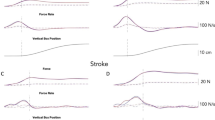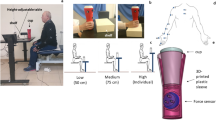Abstract
To evaluate normal and impaired control of anticipatory grip force (GF) modulation, we compared GF production during horizontal arm movements in healthy and post-stroke subjects, and, based on a physiologically feasible dynamic model, determined referent control variables underlying the GF–arm motion coordination in each group. 63% of 13 healthy and 48% of 13 stroke subjects produced low sustained initial force (< 10 N) and increased GF prior to arm movement. Movement-related GF increases were higher during fast compared to self-paced arm extension movements only in the healthy group. Differences in the patterns of anticipatory GF increases before the arm movement onset between groups occurred during fast extension arm movement only. In the stroke group, longer delays between the onset of GF change and elbow motion were related to clinical upper limb deficits. Simulations showed that GFs could emerge from the difference between the actual and the referent hand aperture (Ra) specified by the CNS. Similarly, arm movement could result from changes in the referent elbow position (Re) and could be affected by the co-activation (C) command. A subgroup of stroke subjects, who increased GF before arm movement, could specify different patterns of the referent variables while reproducing the healthy typical pattern of GF–arm coordination. Stroke subjects, who increased GF after arm movement onset, also used different referent strategies than controls. Thus, altered anticipatory GF behavior in stroke subjects may be explained by deficits in referent control.






Similar content being viewed by others
References
Adam JJ, Paas FGWC (1996) Dwell time in reciprocal aiming tasks. Hum Mov Sci 15:1–24. https://doi.org/10.1016/0167-9457(95)00041-0
Allgöwer K, Hermsdörfer J (2017) Fine motor skills predict performance in the Jebsen Taylor Hand Function Test after stroke. Clin Neurophysiol 128:1858–1871. https://doi.org/10.1016/j.clinph.2017.07.408
Anderson AM, Croft RP (1999) Reliability of Semmes Weinstein monofilament and ballpoint sensory testing, and voluntary muscle testing in Bangladesh. Lepr Rev 70:305–313
Blennerhassett JM, Carey LM, Matyas TA (2006) Grip force regulation during pinch grip lifts under somatosensory guidance: comparison between people with stroke and healthy controls. Arch Phys Med Rehabil 87:418–429. https://doi.org/10.1016/j.apmr.2005.11.018
Blennerhassett JM, Carey LM, Matyas TA (2008) Clinical measures of handgrip limitation relate to impaired pinch grip force control after stroke. J Hand Ther 21:245–253. https://doi.org/10.1197/j.jht.2007.10.021
Cole KJ (1991) Grasp force control in older adults. J Mot Behav 23:251–258. https://doi.org/10.1080/00222895.1991.9942036
Cole KJ, Johansson RS (1993) Friction at the digit-object interface scales the sensorimotor transformation for grip responses to pulling loads. Exp Brain Res 95(3):523–532. https://doi.org/10.1007/BF00227146)
Danion F, Sarlegna FR (2007) Can the human brain predict the consequences of arm movement corrections when transporting an object? Hints from grip force adjustments. J Neurosci 27:12839–12843. https://doi.org/10.1523/JNEUROSCI.3110-07.2007
Danion F, Descoins M, Bootsma RJ (2007) Aging affects the predictive control of grip force during object manipulation. Exp Brain Res 180:123–137. https://doi.org/10.1007/s00221-006-0846-3
Dannenbaum RM, Michaelsen SM, Desrosiers J, Levin MF (2002) Development and validation of two new sensory tests of the hand for patients with stroke. Clin Rehabil 16:630–639. https://doi.org/10.1191/0269215502cr532oa
Desrosiers J, Hébert R, Bravo G, Dutil E (1995) The Purdue Pegboard Test: normative data for people aged 60 and over. Disabil Rehabil 17:217–224. https://doi.org/10.3109/09638289509166638
Doeringer JA, Hogan N (1998) Intermittency in preplanned elbow movements persists in the absence of visual feedback. J Neurophysiol 80:1787–1799. https://doi.org/10.1152/jn.1998.80.4.1787
Eslinger PJ, Benton AL (1983) Visuoperceptual performances in aging and dementia: clinical and theoretical implications. J Clin Neuropsychol 5:213–220
Feldman AG (1986) Once more on the equilibrium-point hypothesis (lambda model) for motor control. J Mot Behav 18(1):17–54
Feldman AG (2011) Space and time in the context of equilibrium-point theory. Wiley Interdiscip Rev Cogn Sci 2:287–304. https://doi.org/10.1002/wcs.108
Feldman AG (2015) Referent control of action and perception: Challenging conventional theories in behavioural neuroscience. Springer, New York
Feldman AG (2016) Active sensing without efference copy: referent control of perception. J Neurophysiol 116(3):960–976. https://doi.org/10.1152/jn.00016.2016
Feldman AG (2019) Indirect, referent control of motor actions underlies directional tuning of neurons. J Neurophysiol (review, el.publication ahead of print)
Feldman AG, Levin MF (1995) The origin and use of positional frames of reference in motor control. Behav Brain Sci 18:723–744. https://doi.org/10.1017/S0140525X0004070X
Feldman AG, Krasovsky T, Baniña MC, Lamontagne A, Levin MF (2011) Changes in the referent body location and configuration may underlie human gait, as confirmed by findings of multi-muscle activity minimizations and phase resetting. Exp Brain Res 210:91–115. https://doi.org/10.1007/s00221-011-2608-0
Feys H, Hetebrij J, Wilms G, Dom R, De Weerdt W (2000) Predicting arm recovery following stroke: value of site of lesion. Acta Neurol Scand 102:371–377
Flanagan JR, Tresilian JR (1994) Grip-load force coupling: a general control strategy for transporting objects. J Exp Psychol Hum Percept Perform 20:944–957. https://doi.org/10.1037/0096-1523.20.5.944
Flanagan JR, Wing AM (1997) The role of internal models in motion planning and control: evidence from grip force adjustments during movements of hand-held loads. J Neurosci 17(4):1519–1528
Gilles MA, Wing AM (2003) Age-related changes in grip force and dynamics of hand movement. J Mot Behav 35:79–85. https://doi.org/10.1080/00222890309602123
Gowland C, Stratford P, Ward M, Moreland J, Torresin W, Van Hullenaar S, Sanford J, Barreca S, Bernadette V, Plews N (1993) Measuring physical impairment and disability with the Chedoke-McMaster Stroke Assessment. Stroke 24:58–63
Grichting B, Hediger V, Kaluzny P, Wiesendanger M (2000) Impaired proactive and reactive grip force control in chronic hemiparetic patients. Clin Neurophysiol 111:1661–1671. https://doi.org/10.1016/S1388-2457(00)00355-2
Heckman CJ, Gorassini MA, Bennett DJ (2005) Persistent inward currents in motoneuron dendrites: Implications for motor output. Muscle Nerve 31:135–156
Hermsdörfer J, Hagl E, Nowak DA, Marquardt C (2003) Grip force control during object manipulation in cerebral stroke. Clin Neurophysiol 114:915–929. https://doi.org/10.1016/S1388-2457(03)00042-7
Inglin B, Woollacott M (1988) Age-related changes in anticipatory postural adjustments associated with arm movements. J Gerontol 43:M105–M113. https://doi.org/10.1093/geronj/43.4.M105
Kinoshita H, Francis PR (1996) A comparison of prehension force control in young and elderly individuals. Eur J Appl Physiol Occup Physiol 74:450–460. https://doi.org/10.1007/BF02337726
Latash ML (1992) Virtual trajectories, joint stiffness, and changes in the limb natural frequency during single-joint oscillatory movements. Neurosci 49:209–220. https://doi.org/10.1016/0306-4522(92)90089-K
Latash ML, Anson JG (1996) What are “normal movements” in atypical populations? Behav Brain Sci 19:55–68. https://doi.org/10.1017/S0140525X00041467
Levin MF, Liebermann DG, Parmet Y, Berman S (2016) Compensatory versus noncompensatory shoulder movements used for reaching in stroke. Neurorehabil Neural Repair 30:635–646. https://doi.org/10.1177/1545968315613863
Li Y, Randerath J, Goldenberg G, Hermsdörfer J (2011) Size-weight illusion and anticipatory grip force scaling following unilateral cortical brain lesion. Neuropsychologia 49:914–923. https://doi.org/10.1016/j.neuropsychologia.2011.02.018
Lindstrom-Hazel D, Kratt A, Bix L (2009) Interrater reliability of students using hand and pinch dynamometers. Am J Occup Ther 63:193–197
McDonnell MN, Hillier SL, Ridding MC, Miles TS (2006) Impairments in precision grip correlate with functional measures in adult hemiplegia. Clin Neurophysiol 117:1474–1480. https://doi.org/10.1016/j.clinph.2006.02.027
Nagasaki H (1989) Asymmetric velocity and acceleration profiles of human arm movements. Exp Brain Res 74:319–326. https://doi.org/10.1007/BF00248865
Nowak DA, Hermsdörfer J (2003) Selective deficits of grip force control during object manipulation in patients with reduced sensibility of the grasping digits. Neurosci Res 47:65–72. https://doi.org/10.1016/S0168-0102(03)00182-2
Nowak DA, Hermsdörfer J, Glasauer S, Philipp J, Meyer L, Mai N (2001) The effects of digital anaesthesia on predictive grip force adjustments during vertical movements of a grasped object. Eur J Neurosci 14:756–762. https://doi.org/10.1046/j.0953-816X.2001.01697.x
Nowak DA, Hermsdörfer J, Topka H (2003) Deficits of predictive grip force control during object manipulation in acute stroke. J Neurol 250:850–860. https://doi.org/10.1007/s00415-003-1095-z
Nowak DA, Glasauer S, Hermsdörfer J (2004) How predictive is grip force control in the complete absence of somatosensory feedback? Brain 127:182–192. https://doi.org/10.1093/brain/awh016
Nowak DA, Grefkes C, Dafotakis M, Küst J, Karbe H, Fink GR (2007) Dexterity is impaired at both hands following unilateral subcortical middle cerebral artery stroke. Eur J Neurosci 25:3173–3184. https://doi.org/10.1111/j.1460-9568.2007.05551.x
Park S-W, Marino H, Charles SK, Sternad D, Hogan N (2017) Moving slowly is hard for humans: limitations of dynamic primitives. J Neurophysiol 118:69–83. https://doi.org/10.1152/jn.00643.2016
Pilon JF, Feldman AG (2006) Threshold control of motor actions prevents destabilizing effects of proprioceptive delays. Exp Brain Res 174(2):229–239
Pilon JF, De Serres SJ, Feldman AG (2007) Threshold position control of arm movement with anticipatory increase in grip force. Exp Brain Res 181:49–67. https://doi.org/10.1007/s00221-007-0901-8
Platz T, Pinkowski C, van Wijck F, Kim IH, Di Bella P, Johnson G (2005) Reliability and validity of arm function assessment with standardized guidelines for the Fugl-Meyer Test, Action Research Arm Test and Box and Block Test: A multicentre study. Clin Rehabil 19:404–411. https://doi.org/10.1191/0269215505cr832oa
Raghavan P, Krakauer JW, Gordon AM (2006) Impaired anticipatory control of fingertip forces in patients with a pure motor or sensorimotor lacunar syndrome. Brain 129:1415–1425. https://doi.org/10.1093/brain/awl070
Raghavan P, Santello M, Gordon AM, Krakauer JW (2010) Compensatory motor control after stroke: An alternative joint strategy for object-dependent shaping of hand posture. J Neurophysiol 103:3034–3043. https://doi.org/10.1152/jn.00936.2009
Sangole AP, Levin MF (2009) Palmar arch modulation in patients with hemiparesis after a stroke. Exp Brain Res 199:59–70. https://doi.org/10.1007/s00221-009-1972-5
Shaikh T, Goussev V, Feldman AG, Levin MF (2014) Arm-trunk coordination for beyond-the-reach movements in adults with stroke. Neurorehabil Neural Repair 28:355–366. https://doi.org/10.1177/1545968313510973
Shelton FN, Reding MJ (2001) Effect of lesion location on upper limb motor recovery after stroke. Stroke 32:107–112
Stelmach GE, Nahom A (1992) Cognitive-motor abilities of the elderly driver. Hum Factors 34:53–65. https://doi.org/10.1177/001872089203400107
Tomita Y, Feldman AG, Levin MF (2017) Referent control and motor equivalence of reaching from standing. J Neurophysiol 117:303–315. https://doi.org/10.1152/jn.00292.2016
Wenzelburger R, Kopper F, Frenzel A, Stolze H, Klebe S, Brossmann A, Kuhtz-Buschbeck J, Gölge M, Illert M, Deuschl G (2005) Hand coordination following capsular stroke. Brain 128:64–74. https://doi.org/10.1093/brain/awh317
Werremeyer MM, Cole KJ (1997) Wrist action affects precision grip force. J Neurophysiol 78:271–280. https://doi.org/10.1152/jn.1997.78.1.271
Wiesendanger M, Serrien DJ (2001) Neurological problems affecting hand dexterity. Brain Res Rev 36:161–168. https://doi.org/10.1016/S0165-0173(01)00091-1
Yamanaka J, Feldman AG, Levin MF (2010) Deficits in coordination between grip force and arm movement in stroke. Abstract presented at the American Congress of Rehabilitation Medicine, Montreal, October, 2010. Arch Phys Med Rehabil 91(10):e30
Acknowledgements
The research was partially funded by a grant from CHRP-CIHR-NSERC (Canada) to AGF and MFL, and support from the Eldee Foundation and the Bloomfield family of Montreal, Canada, granted through Tel Aviv University (SFT). Thanks to Ruth Dannenbaum and Valeri Goussev for help with data collection and analysis and to the participants who volunteered for the study.
Author information
Authors and Affiliations
Corresponding author
Ethics declarations
Conflict of interest
The authors declare that they have no conflict of interest.
Ethical approval
All procedures performed in studies involving human participants were in accordance with the ethical standards of the institutional and/or national research committee and with the 1964 Helsinki declaration and its later amendments or comparable ethical standards.
Informed consent
Informed consent was obtained from all individual participants included in the study.
Additional information
Publisher’s Note
Springer Nature remains neutral with regard to jurisdictional claims in published maps and institutional affiliations.
Rights and permissions
About this article
Cite this article
Frenkel-Toledo, S., Yamanaka, J., Friedman, J. et al. Referent control of anticipatory grip force during reaching in stroke: an experimental and modeling study. Exp Brain Res 237, 1655–1672 (2019). https://doi.org/10.1007/s00221-019-05498-y
Received:
Accepted:
Published:
Issue Date:
DOI: https://doi.org/10.1007/s00221-019-05498-y




